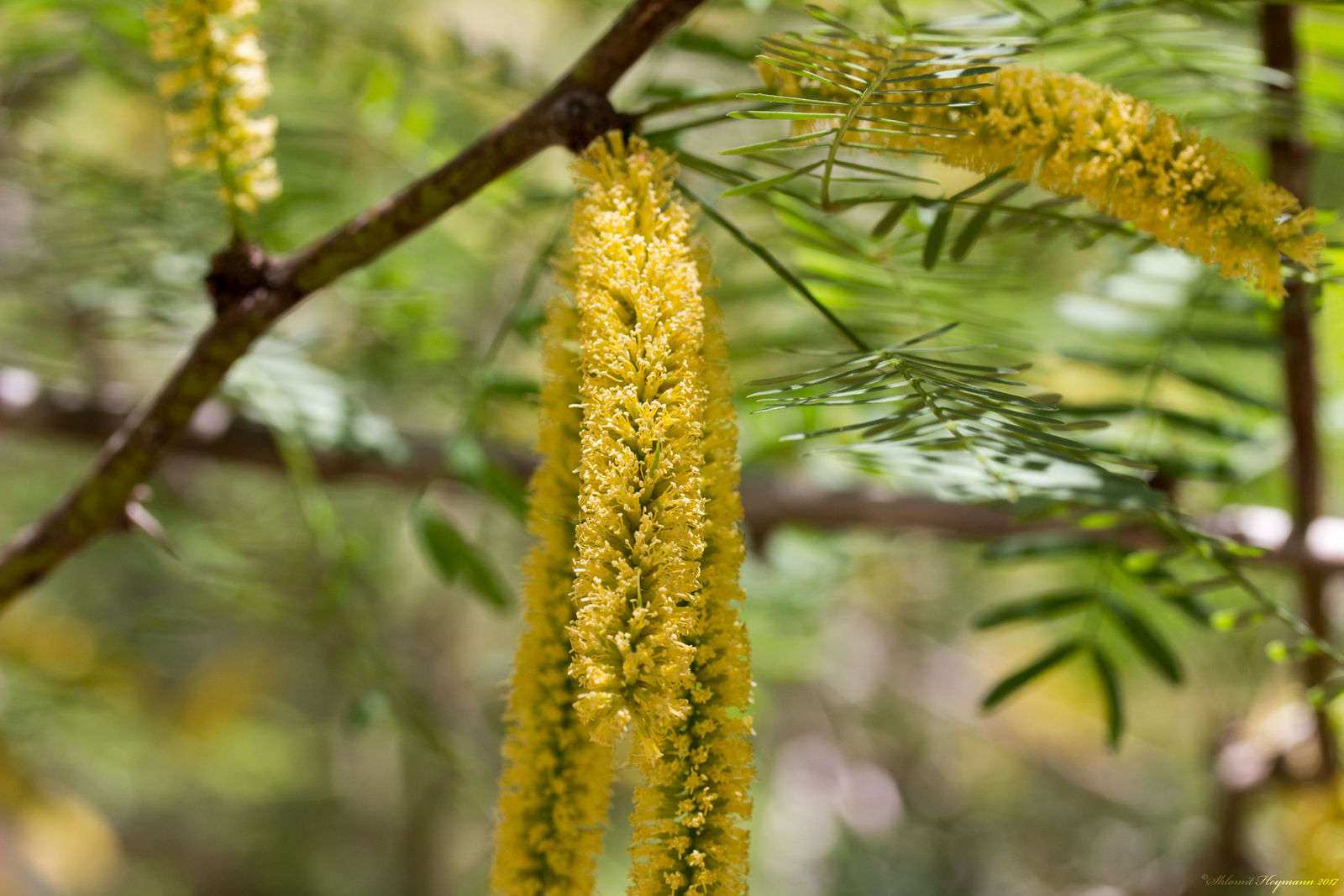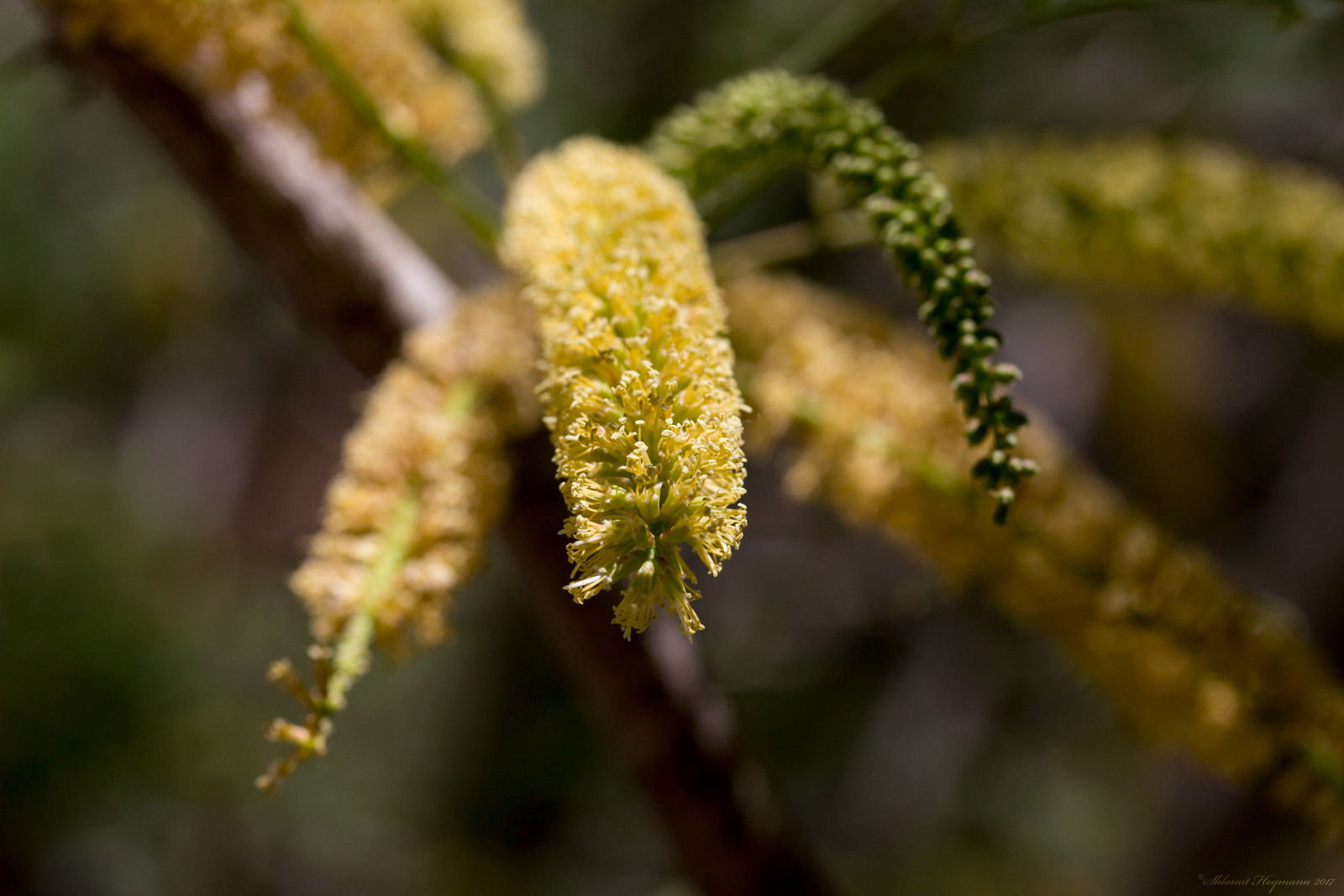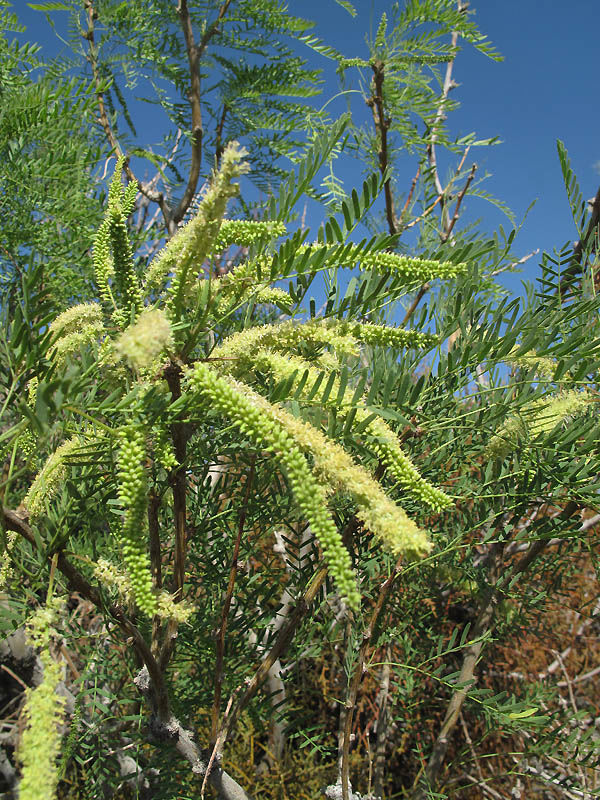Honey Mesquite
prosopis glandulosa
Also known as: ["Texas Mesquite","Honey Mesquite Tree"]
Overview
A deciduous tree native to the Southwestern United States and Northern Mexico, known for its thorny branches and sweet, edible pods.
Benefits & Perks
["drought tolerant","wildlife attractant (bees, butterflies, birds)","edible fruits"]
Botanical Classification
| Phylum: | Magnoliophyta |
| Class: | Magnoliopsida |
| Order: | Fabales |
| Family: | Fabaceae |
| Genus: | Prosopis |
| Botanical Name: | Prosopis glandulosa |
Plant Characteristics
Basic Information
- Category: Trees
- Suitable Location: xeriscaped garden, arid regions, or as a specimen tree in open spaces
- Suitable For:
- Is Weed: No
- Allergenicity: moderate
Environmental Needs
- Climate: {"temperatureRange":"–17 to 46°C"}
- Hardiness: {"zones":"7–11"}
- Misting: rarely required
- Drainage: Fast-draining
- Soil Type: Well-draining, sandy or loamy soil with some organic matter.
Maintenance Level
- Maintenance Level: low
- Toughness Level: high
- Pruning Frequency: Annually or as needed to remove dead wood or shape the plant.
- Pruning Intensity: Moderate to heavy, depending on the desired shape and size.
Care Details
Ideal Sunlight Coverage:
Full sun (6–8 hours of direct sunlight daily). Tolerates intense heat and bright conditions, though some afternoon shade may be beneficial in extreme heat.
Sunlight Tolerance Tips:
Acclimate plants gradually to intense sunlight if moved from shade; avoid sudden exposure to prevent leaf scorch; place in a location with unobstructed sun exposure.
Care Requirements
Care Difficulty
moderatemoderate
Sunlight
full sun
Full sun is essential; avoid deep shade; rotate plant periodically for even growth.
Watering
every 2–3 weeks during active growth, less frequently in winter
Water deeply to encourage deep root growth; allow soil to dry between waterings; adjust frequency based on season and weather.
Soil
well-drained, sandy or loamy soil
pH: Slightly alkaline to neutral (pH 7.0–8.0).
Ensure excellent drainage; avoid heavy clay soils; amend with sand or grit if needed.
Temperature
Thrives in hot, arid conditions. Ideal range is 70–100°F (21–38°C). Tolerates temperatures down to 0°F (-18°C) but prefers warmth.
Protect from frost when young; ensure good air circulation in hot weather; water deeply during heat waves.
Fertilizing
rarely required, annually with slow-release fertilizer if needed
Avoid over-fertilizing; use a balanced fertilizer if soil is poor; fertilize only in spring before new growth.
Propagation
Methods
Stem cuttings or seed. Seeds may require scarification to improve germination.
Step-by-Step Propagation Guide
- Take cuttings or prepare seeds.
- Apply rooting hormone if using cuttings.
- Plant in well-draining medium.
- Maintain warmth and humidity.
Best Time: Spring or early summer when temperatures are warm and growth is active.
Environment
Warm, humid environment with bright indirect light. Maintain consistent moisture but avoid waterlogging.
Medium
Well-draining medium such as cactus mix or perlite and sand mixture.
Hormone
Rooting hormone can be used but is not strictly necessary for stem cuttings.
Timeline
Seeds may take several weeks to months to germinate; stem cuttings may root in 4–8 weeks.
Tools Needed
Pruning shears, rooting hormone (optional), well-draining medium, misting spray bottle.
Quick Tips
Scarify seeds before planting; use bottom heat for faster germination; maintain humidity for cuttings.
Pruning & Repotting
Pruning Guide
Method
Selective pruning to remove crossing or crowded branches; thin out dense growth to improve air circulation.
Pruning Plan
Prune to maintain shape, remove dead or diseased wood, and encourage healthy growth. Prune after flowering or in late winter.
Tools
Pruning shears, loppers, saw (for larger branches), sterilizing solution.
Checklist
Sterilize tools before pruning; prune during dormancy or after flowering; remove dead or diseased wood first.
Repotting Guide
Best Season
Late winter or early spring before new growth begins.
Pot Size
Increase pot size by 2–3 inches (5–7 cm) in diameter.
Method
Gently remove the plant from its container; trim any circling roots; repot in a slightly larger container with well-draining soil.
Suggestions
Repot only if the plant becomes root-bound or outgrows its container. Generally, this species prefers to be slightly root-bound.
Checklist
Check for root-bound roots; trim circling roots; use fresh, well-draining soil; water thoroughly after repotting.
Advanced Care Tips
Watering Mastery
Watering Checklist
Check soil moisture before watering; water deeply at the root zone; ensure proper drainage; adjust frequency seasonally.
How to Apply Water Properly
Water thoroughly at the root zone until water drains from the bottom, ensuring even moisture without waterlogging. Water early in the morning or late in the evening to minimize evaporation.
Watering Schedule Tips
Water deeply but infrequently, allowing soil to dry between waterings. Reduce watering in winter to once every 4–6 weeks, depending on conditions.
Soil Improvement
Add sand or perlite to improve drainage; incorporate compost for organic matter; ensure good aeration to prevent waterlogging.
Temperature Stress Management
Signs of Temperature Issues
Chlorosis or leaf drop in extreme cold; wilting or leaf scorch in excessive heat.
Cold Stress
Low temperatures slow growth and may cause leaf drop or dieback, though established plants are hardy to very low temperatures.
Solution: Protect young or newly planted trees with frost cloth in severe cold; ensure good drainage to prevent root rot in cold, wet soil.
Hot Stress
Excessive heat can cause leaf scorch, wilting, or reduced growth, though the species is highly adapted to heat.
Solution: Provide some afternoon shade in extreme heat; ensure adequate water during prolonged heat waves; mulch to retain soil moisture.
Fertilizing Guide
Fertilizing Checklist
Check soil fertility before fertilizing; use a low-nitrogen fertilizer; apply sparingly in spring.
Fertilizing Method
Generally does not require fertilization due to nitrogen-fixing capabilities. If needed, use a low-nitrogen fertilizer sparingly in spring.
Common Problems & Solutions
Toxicity Warning
Cats
Slightly ToxicCats may experience mild gastrointestinal distress if they ingest the seeds or pods of Prosopis glandulosa. The plant contains compounds that can disrupt digestive processes, leading to discomfort.
⚠️ Symptoms:
🌿 Toxic Parts:
⚡ Toxic If:
if eaten
Dogs
Slightly ToxicThe seeds and pods of Prosopis glandulosa can cause mild gastrointestinal upset in dogs if ingested. The plant contains compounds that may lead to digestive issues, particularly if consumed in significant amounts.
⚠️ Symptoms:
🌿 Toxic Parts:
⚡ Toxic If:
if eaten
Humans
Slightly ToxicProsopis glandulosa, commonly known as honey mesquite, contains compounds that can be mildly toxic if ingested in large quantities. The seeds and pods contain lectins and other compounds that may interfere with nutrient absorption and cause gastrointestinal distress.
⚠️ Symptoms:
🌿 Toxic Parts:
⚡ Toxic If:
if eaten
Frequently Asked Questions
Q: Is Honey Mesquite edible?
A: Yes, the pods are sweet and can be ground into flour or eaten raw.
Q: How drought-tolerant is Honey Mesquite?
A: It is highly drought-tolerant and thrives in arid conditions.
Q: Does Honey Mesquite attract wildlife?
A: Yes, it attracts bees, butterflies, and birds due to its nectar-rich flowers and seeds.
Quick Reference
| Family: | Fabaceae |
| Care: | moderate |
| Light: | full sun |
| Water: | every 2–3 weeks during activ |
Get Expert Care Tips
Download the Plantious app for personalized care reminders and plant identification!
Google Play App Store








